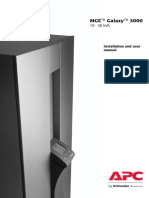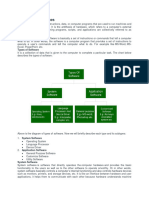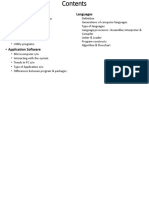0 ratings0% found this document useful (0 votes)
4 viewsLec-1.1 Introduction to System Software
The document provides an overview of system software, including its definition, features, and types such as operating systems, language processors, device drivers, firmware, and utility software. It explains the role of operating systems in managing computer resources and details the functions of language processors like assemblers, compilers, and interpreters. Additionally, it highlights the importance of utility software in maintaining system performance and security.
Uploaded by
ishikasharmaji5861Copyright
© © All Rights Reserved
Available Formats
Download as PDF, TXT or read online on Scribd
0 ratings0% found this document useful (0 votes)
4 viewsLec-1.1 Introduction to System Software
The document provides an overview of system software, including its definition, features, and types such as operating systems, language processors, device drivers, firmware, and utility software. It explains the role of operating systems in managing computer resources and details the functions of language processors like assemblers, compilers, and interpreters. Additionally, it highlights the importance of utility software in maintaining system performance and security.
Uploaded by
ishikasharmaji5861Copyright
© © All Rights Reserved
Available Formats
Download as PDF, TXT or read online on Scribd
You are on page 1/ 24
System Software Full Course
Click Here to Watch Complete Course
Introduction to System Software
Watch Lecture on YouTube
Agenda
Software Language Processors
System Software Types of Language Processors
Features of System Software Device Driver
Types of System Software Firmware
Operating System Utility Software
Tasks of Operating System Features of Utility Software
Software
Software is a set of instructions, which is designed to perform a defined
task, and it tells the computer how to work.
It is of mainly two types
i. Application Software - The term “application software” refers to
software that performs specific functions for a user.
ii. System Software - System software is a set of computer programs
that is designed to manage system resources.
System Software
System software is a software that provides platform to other
softwares.
Some examples can be operating systems, antivirus softwares, disk
formatting softwares, Computer language translators etc.
These softwares consists of programs written in low-level languages,
used to interact with the hardware at a very basic level.
System software serves as the interface between the hardware and the
end users.
System Software
System software runs in the background and manages all functioning of
the computer itself. It is called Low-Level Software as it runs at the
most basic level of computer.
Features of System Software
The most important features of system software include :
▪ Closeness to the system
▪ Fast speed
▪ Difficult to manipulate
▪ Written in low level language
▪ Difficult to design
Types of System Software
System software is of the following types:
1. Operating System
2. Language Translators
3. Device Drivers
4. Firmware Software
5. Utility Software
1. Operating System
An Operating System is the most basic type of System Software that
helps to manage computer hardware and software.
It is the central part of any computer system which is responsible for
the smooth functioning of any computer device.
An Operating system primarily operates your computer when you start
it. If you haven't installed the operating system on your computer, then
you will not be able to start your computer.
Some most common examples of OS are macOS, Linux, Android, and
Microsoft Windows.
Tasks of Operating System
• An OS works as a file manager as It allocates resources to each task
performed in your system.
• It tracks the primary memory and allocates memory to process the
request.
• It works as processor management by allocating RAM to process and
de-allocating when it no longer exists.
• It helps to prevent unauthorized access by encrypting password
facilities.
Tasks of Operating System
• It helps to schedule processes by means of scheduling algorithms.
• It helps to activate all hardware parts of your computer by following
the instruction given by end-users.
• It facilitates users to access and use application software.
• It enables you to access the network on your system.
• It controls all input and output devices such as monitors, keyboards,
microphones, and scanners, etc.
Tasks of Operating System
• It helps to detect and install new software. Further, it also helps in
troubleshooting the errors during installation.
• It helps to link different parts of your system.
2. Language Processor
We know that computers can understand only machine level language,
which is in binary 1 or 0.
The code written in any high-level or low-level languages should be
translated into machine level language and Language Processors are
used for this purpose.
These translators are just computer programs, which accept a program
written in high level or low level language and produce an equivalent
machine language program as output.
Types of Language Processor
The three types of translators used are-
i. Assembler
ii. Compiler
iii. Interpreter
i. Assembler
The Assembler is used to translate the program written in Assembly
language into machine code.
The source program is an input of an assembler that contains assembly
language instructions. The output generated by the assembler is the
object code or machine code understandable by the computer.
ii. Compiler
The language processor that reads the complete source program
written in high-level language as a whole in one go and translates it
into an equivalent program in machine language is called a Compiler.
Example: C, C++, C#, Java.
In a compiler, the source code is translated to object code successfully
if it is free of errors.
The compiler specifies the errors at the end of the compilation with
line numbers when there are any errors in the source code.
The errors must be removed before the compiler can successfully
recompile the source code again.
iii. Interpreter
The translation of a single statement of the source program into
machine code is done by a language processor and executes
immediately before moving on to the next line is called an interpreter.
If there is an error in the statement, the interpreter terminates its
translating process at that statement and displays an error message.
The interpreter moves on to the next line for execution only after the
removal of the error from previous line.
This process continues until the last statement of program.
Example: Perl, Python and MATLAB.
3. Device Driver
Device Driver is a type of system software which controls a specific
hardware device.
It enables different hardware devices for communication with the
computer’s Operating System.
Device Drivers are very essential for a computer system to work
properly because without device driver the particular hardware fails to
work accordingly means it fails in doing a particular function/action for
which it has been created.
Most of the device drivers, such as a
mouse, keyboards, etc., are already
installed in the computer system by the
computer manufacturing companies.
However, in case of any new device for the
operating system, users can install them
through the internet also.
4. Firmware Software
These are the operational software installed on the computer
motherboards that help the operating system to identify the Flash,
ROM, EPROM, EEPROM, and memory chips.
However, the primary function of any firmware software is to manage
and control all activities of individual devices. Initially, it uses non-
volatile chips for installation purposes, but later it gets installed on the
flash chips.
5. Utility Software
Utility software works as an interface between system software and
application software.
Utility software is a third-party tool designed to reduce maintenance
issues and detect errors in the computer system.
It comes with the operating system in your computer system.
E.g. Antivirus, File Management System, Disk Management tools,
Compression tools, Disk cleanup tool, Disk Defragmenter, Backup
utility.
Features of Utility Software
• It helps users to protect against threats and viruses.
• It helps to reduce disk size such as WinRAR, WinZip.
• It works as a Windows Disk Management service and helps in a disk
partition.
• It facilitates users to back up the old data and enhance the security of
the system.
• It works as a de-fragmentation of a disk to organize the scattered files
on the drive.
• It helps to recover the lost data.
Mail your queries at
firstcodehelpdesk@gmail.com
company/firstcodeyt @firstcodeyt @firstcodeyt @firstcodeyt
@firstcodeyt
You might also like
- MGE Galaxy 3000: Installation and User Manual100% (1)MGE Galaxy 3000: Installation and User Manual56 pages
- Plekhanov Russian University of Economics International Business SchoolNo ratings yetPlekhanov Russian University of Economics International Business School7 pages
- CF-4 Intro software and operating systemNo ratings yetCF-4 Intro software and operating system9 pages
- 3 Basics of Computers - Software ConceptsNo ratings yet3 Basics of Computers - Software Concepts2 pages
- Applicartion Software and System SoftwareNo ratings yetApplicartion Software and System Software28 pages
- Software Suite: Revolutionizing Computer Vision with the Ultimate Software SuiteFrom EverandSoftware Suite: Revolutionizing Computer Vision with the Ultimate Software SuiteNo ratings yet
- Problem 1 - Murphy Pushes The Power Button On Her Computer and Nothing Happens. List All of The Possibilities in Flow Chart Form On How She WouldNo ratings yetProblem 1 - Murphy Pushes The Power Button On Her Computer and Nothing Happens. List All of The Possibilities in Flow Chart Form On How She Would1 page
- ឆ១ឆ្នាំ១ core english 2024 ict en with answerNo ratings yetឆ១ឆ្នាំ១ core english 2024 ict en with answer3 pages
- Module 3 - Configure Computer Systems and Networks - RonyNo ratings yetModule 3 - Configure Computer Systems and Networks - Rony83 pages
- Instruction Manual MODEL 3060 Constant Speed Mixer: Revision E.8 - February 2008 P/N: 30-060-0 S/N100% (1)Instruction Manual MODEL 3060 Constant Speed Mixer: Revision E.8 - February 2008 P/N: 30-060-0 S/N20 pages
- Plekhanov Russian University of Economics International Business SchoolPlekhanov Russian University of Economics International Business School
- Software Suite: Revolutionizing Computer Vision with the Ultimate Software SuiteFrom EverandSoftware Suite: Revolutionizing Computer Vision with the Ultimate Software Suite
- Software Design And Development in your pocketFrom EverandSoftware Design And Development in your pocket
- Problem 1 - Murphy Pushes The Power Button On Her Computer and Nothing Happens. List All of The Possibilities in Flow Chart Form On How She WouldProblem 1 - Murphy Pushes The Power Button On Her Computer and Nothing Happens. List All of The Possibilities in Flow Chart Form On How She Would
- Module 3 - Configure Computer Systems and Networks - RonyModule 3 - Configure Computer Systems and Networks - Rony
- Instruction Manual MODEL 3060 Constant Speed Mixer: Revision E.8 - February 2008 P/N: 30-060-0 S/NInstruction Manual MODEL 3060 Constant Speed Mixer: Revision E.8 - February 2008 P/N: 30-060-0 S/N































































































